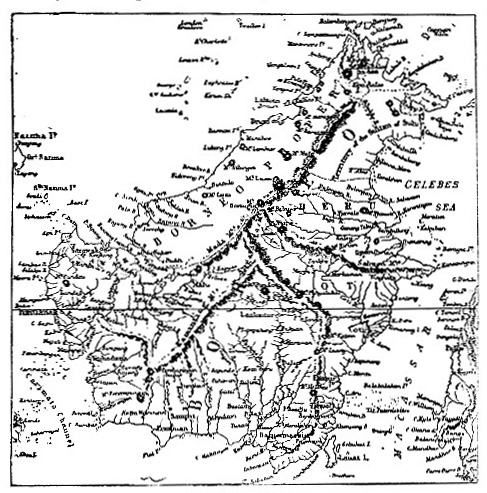Borneo - Introduction
BORNEO, one of the largest islands of the world, is situated about the middle of the East Indian Archipelago, and lies immediately under the equator, between 7° N. and 4° 20' S. lat., and between 109° and 118° E. long.
It forms a kind of irregular hexagon, and its area is estimated by Engelhardt at 289,000 English square miles (more than double the area of the United Kingdom).
Its coastline is much less broken than that of most of the neighbouring islands; and though there are some extensive bays, such as Maludu in the north and Sarawak in the west, none of them are so deep as greatly to interfere with the regularity of its contour.
A large proportion of the seaboard is of alluvial formation; and in various districts the deposition of new land is very perceptibly going on. The whole of the ground, for example, to the west of the Kandang Mountains in the kingdom of Landak has been gained from the sea during the last four centuries, and it is evident that many smaller islands which fringed the coast in former times have been incorporated with the mainland. This process of extension goes on all the more rapidly, because the neighbouring sea is very shallow, except on the eastern side.
Borneo - Mountains
Of the interior of the island a considerable part has been only partially explored, so that the physical features can hardly be given with sufficient precision and detail. The general character of the country is mountainous, though none of the ranges and few of the individual peaks attain to any great elevation.
The centre of the island seems to be occupied by a kind of tableland, with which the principal chains connect themselves more or less directly. Of these the most extensive may be traced from Cape Dath, on the west coast, in 2° 5' 24" N. lat., northwards through the length of the island, which it divides as watershed into two portions, a north-western of comparatively narrow dimensions, and a south-eastern comprising the rest of the island. The different parts of the chain are known by various local names, as the Krimbang or Bayang-Miut, the Batang-Lupar, the Madi, and the Anga-Anga Mountains.
In the north-west corner of the island it attains its highest elevation in Kini-balu [Gunung Kinabalu], or St Pietersberg, which is generally supposed to be the highest peak in the whole island. According to the trigonometrical measurement of Capt. Belcher the summit is 13,698 feet above the level of the sea, but this was in 1851 reduced to 9500 by Messrs Low and St John, who were the first to ascend the mountain.
A second great chain, known as the Kamingting Mountains, stretches south-west from the Anga-Anga, and fills the south-west corner of the island with numerous offshoots and underfalls; and a third starting from the same quarter strikes first south-east and then south along the southern part of the eastern coast, and is known as the Meratu Mountains.
A fourth chain, of which the most important part bears the name of Sakuru, runs almost due east to Cape Kamiungun.
Unlike the most of the larger islands of the archipelago, and in remarkable contrast with Java, Borneo seems to possess no active volcanoes. Many of the peaks, however, bear distinct evidence of former activity in regular craters, now in some cases forming lakes of salt water. The prevailing rocks are limestone, slate, sandstones, conglomerates, and on the mountain tops syenitic granite. The limestone hills are remarkable for the number of their caves, many of which, such as those of Rumbary, are a source of wealth to the natives, as they afford shelter to swallows that build edible nests.
Read the rest of this article:
Borneo - Table of Contents
